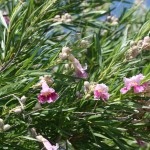Desert Willow
Chilopsis linearis
Bignoniaceae
Description
Desert Willow is a small (20 to 30 ft or 6 to 9 m), loose, and often twisting and/or leaning tree in the Trumpet Creeper (Bignoniaceae) Family. Jan Wrede in Trees, Shrubs, and Vines of the Texas Hill Country describes it as having “gorgeous, lavender-pink, trumpet-shaped flowers with willow-like leaves.” When it is young, the bark is smooth but becomes ridged with deep fissures as it matures. The deciduous leaves are very narrow and willow-like. They are opposite or alternately attached. Sometimes the leaves can be sticky, particularly the varieties found in the Big Bend, and their length varies from 3 to 10 inches tapering to a narrow tip, but generally are around 4 inches long. After heavy rains from May to September, the showy clusters of tubular, sweetly fragrant flowers bloom on new wood in terminal racemes. The flowers with five ruffled petal-like lobes are usually pink or lavender in color but can be white or dark rose. Desert Willow's flowers are 1 to 3 inches long and will also have a purple, white, or yellow stripe that leads to the pollen. Its fruit is a slender, woody pod that is 5 to 8 inches long and contains numerous flat, oval, and winged seeds with hairy tufts. New pods are green, mature to a brown color, and often persist to the following spring. Foliage is unpalatable, and livestock only eat it when under stress. Desert Willow can be used for erosion control, and its drought tolerance and fast growth have made it a nursery trade favorite. There are over 20 cultivars and several intergeneric hybrids with Catalpa.Habitat
Desert Willow is found along well-drained soils, dry beds, and streams from the western edge of the Texas Hill Country and further west. It can grow in most soils.Images
Plant Characteristics
Flower Color: Pink, Purple, White
Seed Type: Bean/Pod
Duration: Perennial
Stem Texture: Hairless/Smooth
Growth Habit: Shrub (Woody)
Leaf Shape
 : Simple with Pinnate or Parallel Venation
: Simple with Pinnate or Parallel Venation
Season: Warm
Distribution
 : 03 - Post Oak Savannah, 05 - Cross Timbers and Prairies, 06 - South Texas Plains, 07 - Edwards Plateau, 09 - High Plains, 10 - Trans-Pecos
: 03 - Post Oak Savannah, 05 - Cross Timbers and Prairies, 06 - South Texas Plains, 07 - Edwards Plateau, 09 - High Plains, 10 - Trans-Pecos
Distributions
Distribution refers to the ecological region in Texas that a plant has been found. You can also view a clickable map.
Collection: Brush and Weeds





